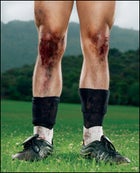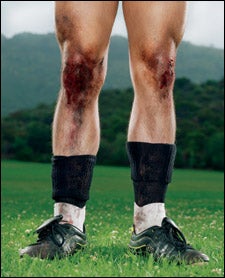Thank Australopithecus for standing upright more than three million years ago and making possible such great human achievements as the four-minute mile, the 360 dunk, and the Eddie Van Halen guitar solo. Of course, A-Man also sentenced our knees to an eternity of trouble: clicks, creaks, tweaks, tears, and pops that can make bipedalism look downright backwards. Considering all that this joint does for us, it’s no surprise that knee problems some 9.5 million annually in the U.S. are the leading reason people see orthopedic specialists. That said, there are ways to avoid visiting the doc. Follow our guide to proper care and maintenance, including training and rehab secrets of the pros, and you’ll stay in the game longer and stronger. Your knees have evolved nicely over the eons; it’s high time the care you give them catches up.
bodywork knees

Axis of Evil
Even if you avoid traumatic injury, these three forces are conspiring against your knees
Q&A: Should I take glucosamine?
Yes, if you’re suffering pain from osteoarthritis or are at risk for it. Both glucosamine and chondroitin, each found naturally in cartilage, help make the tissue shock-resistant. A recent National Institutes of Health┬ľsponsored study determined that these supplements can help people with arthritis symptoms. Recommended daily dosage: 1,500mg of glucosamine; 800mg to 1,200mg of chondroitin. Both are available over the counter.
1. AGE
As you grow older, circulation and muscles both tend to get weaker. In your joints, lubricating synovial fluid decreases and dries up. Soft tissue becomes less elastic and more susceptible to micro-tears; cartilage gets brittle and begins to
2. BIOMECHANICS
Bowed legs, flat feet, pronating ankles, knock-knees, recurring injuries┬Śany number of things can throw off proper alignment of your joints, and in time even minor tracking deviations can result in major problems. The kinetic chain that links your feet to your hips is highly interdependent: If one part veers off, the entire system can break down.
3. MUSCLE IMBALANCE AND OVERUSE
Simply put, too much of one sport or exercise creates disproportionate musculature. Cyclists, for example, often develop quads that are far stronger than corresponding hamstrings. This may be great for hammering your pals on Saturday morning, but it can leave the knee susceptible to injury, because underdeveloped muscles can’t counter the force of stronger ones. Devotees of high-impact activities, like running and most ball sports, also increase their chances of knee problems if they don’t mix in low-impact alternatives such as swimming and cycling.
Please Your Knees
Now that you know the bad news, you’re ready for the good—and there’s plenty of it. You can stack the deck in favor of lifelong healthy knees with a balanced strength-and-conditioning program, regular flexibility training, and joint-smart nutrition. The single most important thing you can do? Give your knees maximum muscular protection. Deliver the goods w
Q&A: Why is R.I.C.E. important after an injury?
It helps control swelling: Rest your knee, ice it for up to 30 minutes every two hours, compress it with a bandage, and elevate it, until swelling subsides. This will minimize scar tissue, a significant cause of osteoarthritis.Watch a ╠řon ║┌┴¤│ď╣¤═° Television.
Sport-Specific Training: Improve performance and decrease risk of injury by prepping your knees for mogul fields, marathons, and other target=ed activities. Wendy McClure, personal trainer and co-owner of Body Dynamics in Boulder, Colorado, advises pro clients to incorporate these exercises into workouts three times per week, starting two months prior to the season. To increase difficulty, hold weights for more resistance and place a pillow underfoot to create instability.
╠ř
Cycling Split Squats╠ř
Stand with one foot forward, one back, a few feet between them and your hips square. Lower until your back knee almost touches the floor, then rise. Continue 30 seconds, then switch stance and repeat.
Skiing Sideways Squats
Stand sideways a few feet from a wall and lean toward the wall, bracing yourself with your hand. Your unweighted inside leg is bent. Lower into a squat on the outside leg, then rise. Do two 30-second sets. Switch sides and repeat.
Hiking Partial Step-Throughs
On a narrow step deck or platform, step up on your right leg, and bring the left up and through as if you’re going to step down to the other side, but dip down only about 15 degrees, then move back to the start position. You should be balanced on the same leg throughout the movement. Repeat for 30 seconds on each leg.
Running Paper-Plate Half Circles
Set a paper plate on the floor one stride length behind you. Balance on your left leg while extending your right foot back so your toes are lightly resting on the plate. Sink into a semi-squat position on your left leg. Now trace a full half circle with your right leg (don’t let your knee dip inward), sliding the plate along the floor until it’s in front of you. Slide plate straight back. Repeat 30 seconds on each leg.
Negatives and Plyometrics: Conventional weight-lifting programs strengthen muscles as they contract. Problem is, real-world sports often demand that your muscles lengthen under load. It’s called an eccentric action, and it’s what happens when you control your descent while hiking, running, or skiing. Work this braking action with negatives and plyos, which rely on resistance rather than lifting. For the following exercises, focus on excellent form and slow, natural rhythm.
Drop Jumps
On a box, step, or platform (start small), step up and drop to the floor, lowering into a squat, then spring straight up. Four sets of six to ten. Advanced: Hold a medicine ball over your head.
Front Squats
Hold an unweighted squat bar at the top of your chest. Lower into a squat on a ten-count pace, then explode up. Three sets of four to six. Advanced: Add 10 to 20 pounds.
Single-Leg Hops
On a level stretch of grass or track, leap forward from one foot to the other for approximately 20 yards. With each landing, hold yourself still, balanced on one leg, for five seconds. Do four sets. Advanced: Jump at a slight angle, alternating sides, and touch the ground with your outside hand on each landing.
Downhill Repeats
Fill a pack with weight (start light and increase gradually). On a sloping trail, hillside, or stadium steps, hike to the top and descend in small bounds. Keep your knees bent slightly, so they absorb impact like shocks during the descent. Do four to six reps of 50 yards. Advanced: Add weight and do reps of 100 yards.
MIX AND MATCH
You know cross-training is smart, but do you know how to choose a complementary combination of high- and low-impact activities? Use this guide to get the most out of multisport.
Sport: Running
Complement: Swimming with fins
Payoff: Adds low-impact balance to your routine. Fins help isolate quads and hamstrings to build leg strength.
Sport: Skiing
Complement: In-line skating
Payoff: Lateral movement mimics skiing motion, so you build hip strength and muscle endurance.
Sport: Cycling
Complement: Running
Payoff: The higher-impact activity helps promote bone density, build leg strength, and keep your weight down.
Sport: Mountain climbing & hiking
Complement: Mountain biking
Payoff: Pedaling up steep, technical trails develops leg and core strength. And descending? Well, some things are just for fun.
Care and Maintenance
Strength is just the start. Now add a healthy diet, proper form, and regular stretching.
Q&A: When should I retire my running shoes?
When they’re worn out, of course, but brace yourself: That could be sooner than you think. “If you’re running a few times a week or more, you should probably be replacing them every six months,” advises McClure. While the shoes may show limited exterior signs of wear, the interior midsole may have lost essential cushioning.
 PASS THE GUAC: the oil in avocados promotes joint health.
PASS THE GUAC: the oil in avocados promotes joint health.FEED YOUR KNEES
Your joints, like the rest of your body, need plenty of fruits and vegetables. Even recreational athletes require a minimum of five servings of each per day. It’s the only way to get the micronutrients vitamins and minerals you won’t get from other food. “Your body needs calcium, magnesium, zinc, and vitamin C to heal injuries,” says Dr. William Sterett, of Vail, Colorado’s Steadman Hawkins Clinic, a top orthopedic center. “Multivitamins can help, but nothing delivers nutrients as well as fresh foods.” Joints also benefit from essential oils: Add oily fish (or omega-3 supplements), olive oil, avocados, and almonds to your meals a few times a week.
GET AN ALIGNMENT
Check your musculoskeletal symmetry with this simple test. Stand on a step, facing down. Put one foot forward, so you’re supported on one leg. Dip down until your supporting knee is bent about 30 degrees, then stand back up. Watch your weight-bearing knee: If it deviates from a straight path (don’t panic, most do), you could have alignment issues. Correction may require expert help from an orthopedist or experienced trainer but the following easy fixes often solve minor problems.
1.> Shoe Inserts Creating a stable, neutral platform under your foot is step one, and an over-the-counter insole is an inexpensive, effective way for most people to get the necessary support. Many ski boots have “cantable” cuffs to accommodate off-center alignment. Have a shop help you; it’s quick and simple.
2.> Bike Fit Saddle height and forward reach are the two macro-adjustments you need to consider. There should be a slight bend in the knee at the bottom of the pedal stroke, and the reach will be determined by how aggressively you ride. “Recreational riders will have a torso tilting at 45 degrees or greater,” says Andy Pruitt, a cycling-biomechanics expert and the clinical director at Colorado’s Boulder Center for Sports Medicine. “Racers will be 45 degrees or less.”
3.> Good Form “Whether your sport is static or dynamic, in order to maintain good alignment you need to have proper form,” says Dr. Raffy Mirzayan, an orthopedic surgeon who has worked with the Los Angeles Lakers and Dodgers. Quick tips: Runners, reduce side-to-side movement in your arms, shoulders, and torso. Cyclists, develop a rounder pedal stroke by staying seated and spinning in a lower gear on climbs. Skiers, keep your shoulders square to the fall line by actively reaching your uphill hand downhill.
FLEX TIME
Tight muscles are like weak muscles: bad for your joints. Yoga, Pilates, and sport-specific warm-up routines are great ways to keep limber, particularly if you’re a desk jockey all week, as hours in a chair promote tighter limbs and impaired circulation. Do a ten-minute light aerobic warm-up, followed by ten minutes of activity-specific stretching, before every workout. Start here:
1.> Runner’s Lunge Step one foot forward and drop until your rear knee almost touches the ground. Let your back heel rise, then sink into a stretch.
2.> Quad Stretch Brace on a wall, rail, or friend. Grab one foot and pull it back against your butt. Better yet, do the same stretch lying facedown.


